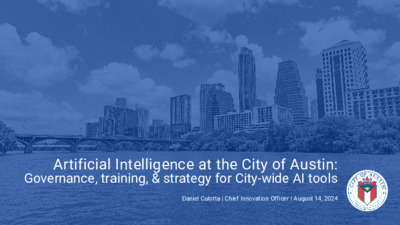Item 3: Prestation on AI training for CoA employees — original pdf
Backup

Artificial Intelligence at the City of Austin: Governance, training, & strategy for City-wide AI tools Daniel Culotta | Chief Innovation Officer | August 14, 2024 Contents 1. History 2. Policies and Guidelines 3. Training 4. Security and Monitoring 5. Governance 6. Pilots, Studies, Tools, and Use Cases 7. Future 2 Background Increasing staff inquiries on AI use, availability, rules, etc. Form AI working group to create guidelines, research how AI is used in the org. Update security and privacy policies. Summer 2023 Fall 2023 Spring 2024 Summer 2024 Begin AI tool and use research Guidelines, GovAI Coalition, Training Use cases and Council Resolution Departments create applications and use cases. City Council passes resolution to form an AI Advisory Committee, security guidelines, and workforce plan. Continue to participate in GovAI Coalition working groups, help develop templates. Governance City core team works on resolution, recruits AIAC and facilitates meetings. Core team creates AI plan to fulfill AIAC recommendations and advance internal AI strategy. Working group continues internal research, benchmarking. Create Generative AI Standards. Join GovAI Coalition with gov partners to share experiences and resources. Provides data ethics, governance, and AI tool training to City staff. City of Austin AI Strategy Pillars Policies & Guidelines asdf Training Governance Security & Monitoring Tools & Use Cases 4 Policies & Guidelines Training Security & Monitoring Governance Tools & Use Cases Policies and Guidelines Current COA policies and guidelines ● City of Austin Code of Ordinances, Chapter 2-11 Additional plans and guidelines in development Vendor FactSheet ● Vendor Agreement ● ● Use Case Template Information Management Security and Privacy Controls Policy Information Privacy Program Charter ● ● ● Data Classification Policy ● Cybersecurity Incident Response Plan ● Policy Clarification on the Use of AI Services for City Data Processing ● Generative AI Standards ● Acceptable Use Policy ● ● Employees required to report AI use Employees required to cite use 5 Policies & Guidelines Training Security & Monitoring Governance Tools & Use Cases Training and Workforce Readiness Training ● Provide training via courses, learning cohorts, speakers, use cases, and online resources ● Developing mandatory training on proper use and policies ● Developing and consolidating training and skills-building resources accessible to all employees ● More extensive training for specific use cases Workforce Readiness ● Gathering feedback and data on use cases, tools, readiness ● Identify, assess, and prioritize high-value use cases, processes, work flows ● Identify potentially impacted job classes and plan for training, reskilling, etc. 6 Policies & Guidelines Training Security & Monitoring Governance Tools & Use Cases Security and Monitoring ● Per Generative AI Standards, employees responsible for checking for errors and bias ● Security and Privacy assessments during technology procurement ● Vendor FactSheet and Agreement tools to understand and assess architecture, training, outputs ● Evaluating existing security and privacy tools, third-party assessments and tools to fill gaps ● Plan to pilot enterprise instance of generative AI to increase security and control ● Creating process for reporting errors and bias for future public-facing tools 7 Policies & Guidelines Training Security & Monitoring Governance Tools & Use Cases Governance ● Internal core team (IT, Privacy, Security, Law, Innovation, HR) ● External AI Advisory Committee (industry, university, community partners) ● GovAI Coalition (nationwide government partners) ● Citywide Technology Selection and Approval process 8 Policies & Guidelines Training Security & Monitoring Governance Tools & Use Cases Pilots, Studies, Tools, and Use Cases Real-time fire tracking and smoke Impact analysis ● Ambulance routing optimization ● ● Grant information synthesis ● Multilingual emergency preparedness and communications research IT service ticket analysis ● ● Non-emergency call routing ● Documentation authoring tool ● ● Smart hand tools Traffic management and safety Future ● Chatbot pilot ● ● Routing model for IT service tickets Proactive use case piloting 9 Next Steps ● Develop and evaluate use cases ● Monitor use and development, adjust policies and guidelines accordingly ● Continue to develop vendor processes and relationships ● Expand and diversify training 10 Thank you! innovation@austintexas.gov